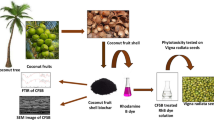Abstract
Mineralization of Reactive Brilliant Red X-3B by a combined anaerobic–aerobic process which was inoculated with the co-culture of Penicillium sp. QQ and Exiguobacterium sp. TL was studied. The optimal conditions of decolorization were investigated by response surface methodology as follows: 132.67 g/L of strain QQ wet spores, 1.09 g/L of strain TL wet cells, 2.25 g/L of glucose, 2.10 g/L of yeast extract, the initial dye concentration of 235.14 mg/L, pH 6.5, and 33 °C. The maximal decolorization rate was about 96 % within 12 h under the above conditions. According to the Haldane kinetic equation, the maximal specific decolorization rate was 89.629 mg/g˙h. It was suggested that in the anaerobic–aerobic combined process, decolorization occurred in the anaerobic unit and chemical oxygen demand (COD) was mainly removed in the aerobic one. Inoculation of fungus QQ in the anaerobic unit was important for mineralization of X-3B. Besides, the divided anaerobic–aerobic process showed better performance of COD removal than the integrated one. It was suggested that the combined anaerobic–aerobic process which was inoculated with co-culture was potentially useful for the field application.







Similar content being viewed by others
References
Forgacs, E., Cserháti, T., & Oros, G. (2004). Environ. Int, 30, 953–971.
Spadaro, J. T., Gold, M. H., & Renganathan, V. (1992). Appl. Environ. Microbiol, 58, 2397–2401.
Pandey, A., Singh, P., & Iyengar, L. (2007). Int. Biodeterior. Biodegrad, 59, 73–84.
van der Zee, F. P., & Villaverde, S. (2005). Water Res, 39, 1425–1440.
Verma, P., & Madamwar, D. (2003). World J. Microbiol. Biotechnol, 19, 615–618.
Gou, M., Qu, Y. Y., Zhou, J. T., Ma, F., & Tan, L. (2009). J. Hazard. Mater, 170, 314–319.
Hofrichter, M. (2002). Enzyme Microb Technol, 30, 454–466.
Chen, K. C., Wu, J. Y., Liou, D. J., & Hwang, S. C. (2003). J. Biotechnol, 101, 57–68.
Blümel, S., & Stolz, A. (2003). Appl. Microbiol. Biotechnol, 62, 186–190.
Heinfling, A., Bergbauer, M., & Szewzyk, U. (1997). Appl. Microbiol. Biotechnol, 48, 261–266.
Balan, D. S. L., & Monteiro, R. T. R. (2001). J. Bacteriol, 89, 141–145.
Casieri, L., Varese, G. C., Anastasi, A., Prigione, V., Svobodová, K., Fillppelo Marchisio, V., & Novotný, C. (2008). Folia Microbiol, 53, 44–52.
Muthukumar, M., & Selvakumar, N. (2004). Dyes Pigm, 62, 221–228.
Boer, W., Folman, L. B., Summerbell, R. C., & Boddy, L. (2005). FEMS Microbiol Rev, 29, 795–811.
Pennisi, E. (2004). Science, 304, 1620–1622.
Kapdan, I. K., & Alparslan, S. (2005). Enzyme Microb Technol, 36, 273–279.
Supaka, N., Juntongjin, K., Damronglerd, S., Delia, M. L., & Strehaiano, P. (2004). Chem. Eng. J, 99, 169–176.
Tan, L., Qu, Y. Y., Zhou, J. T., Ma, F., & Li, A. (2009). Bioresour Technol, 100, 3003–3009.
Zhang, C. H., Ma, Y. J., Yang, F. X., Liu, W., & Zhang, Y. D. (2009). Bioresour Technol, 100, 4284–4288.
Zhao, L. J., Zhou, J. T., Jia, Y. H., & Chen, J. F. (2010). J. Hazard. Mater, 181, 602–608.
Sharma, S., Malik, A., & Satya, S. (2009). J. Hazard. Mater, 164, 1198–1204.
Montgomery, D. C. (1991). Design and analysis of experiments. New York: Wiley.
Mohana, S., Shrivastava, S., Divecha, J., & Madamwar, D. (2008). Bioresour Technol, 99, 562–569.
Mohana, S., Desai, C., & Madamwar, D. (2007). Bioresour Technol, 98, 333–339.
Khehra, M. S., Saini, H. S., Sharma, D. K., Chadha, B. S., & Chimni, S. S. (2005). Dyes Pigm, 67, 55–61.
Hu, T. L. (1994). Bioresour Technol, 49, 47–51.
Kaushik, P., & Malik, A. (2009). Environ Int, 35, 127–141.
Kolekar, Y. M., Pawar, S. P., Gawai, K. R., Lokhande, P. D., Shouche, Y. S., & Kodam, K. M. (2008). Bioresour Technol, 99, 8999–9003.
Chen, B. Y. (2002). Process Biochem, 38, 437–446.
Lin, J., Zhang, X., Li, Z., & Lei, L. (2010). Bioresour Technol, 101, 34–40.
Acknowledgments
The authors gratefully acknowledge the financial support from the National Natural Science Foundation of China (nos. 51078054, 51108120, and 51178139), the National Creative Research Group from the National Natural Science Foundation of China (no. 51121062), the 4th China Postdoctoral Science Special Foundation (no. 201104430), and the 46th China Postdoctoral Science Foundation (no. 20090460901).
Author information
Authors and Affiliations
Corresponding authors
Rights and permissions
About this article
Cite this article
Shi, S., Ma, F., Sun, T. et al. Mineralization and Kinetics of Reactive Brilliant Red X-3B by a Combined Anaerobic–Aerobic Bioprocess Inoculated with the Coculture of Fungus and Bacterium. Appl Biochem Biotechnol 172, 1106–1120 (2014). https://doi.org/10.1007/s12010-013-0550-2
Received:
Accepted:
Published:
Issue Date:
DOI: https://doi.org/10.1007/s12010-013-0550-2




